Over the years, I’ve been on many camping trips where it started to rain. A few times, there was even thunderstorms and once a giant hail storm!
While it might seem like rain would ruin a camping trip, it doesn’t have to. With the right gear and preparation, you can still enjoy your trip. But, if you aren’t prepared, rain can make your camping trip pretty miserable (or even dangerous). So, before you set out, read this to learn what to do when it starts raining while camping.
Jump to:
- Gear for Camping in the Rain
- If you Have Kids
- Choosing a Rain-Safe Campsite
- Setting Up a Tent for Rain
- Cooking in the Rain while Camping
- Making a Campfire during/after Rain
- Other Tips for Camping in the Rain
Gear for Camping in the Rain
Even if the forecast calls for sunshine, you should always pack as though it is going to rain. The weather can change pretty quickly. In the mountains, I’ve experienced bright sunny weather that turned into a thunderstorm in just 10 minutes!
*Because the weather can change so quickly, it’s important that you bring the right gear while on day hikes too. See this hiking gear checklist.
Below is a list of the absolute minimum gear you will need for camping in the rain.
1. Waterproof tent
A hydrostatic head of at least 2000 is recommended. You can also use a tarp + rope, but this requires a higher level of knowledge. More below on how to set up your tent for rain. I’ll also talk below about what to do if your tent isn’t waterproof.
2. Waterproof jacket or poncho
Be warned that “water resistant” and “waterproof” are NOT the same. Most hiking jackets are only water-resistant. They might keep you dry in a light shower, but you will be drenched if a downpour occurs.

Sitting outside after a huge thunderstorm. My rain jacket also acts as a windbreaker to keep me warm despite the heavy winds.
3. Waterproof cover for your backpack
Trash bags can work for this, but preferably you have a fitted cover. The backpack cover shown below comes in different sizes (10-90 liters) and colors. It will keep gear in your pack dry. You can get it here.
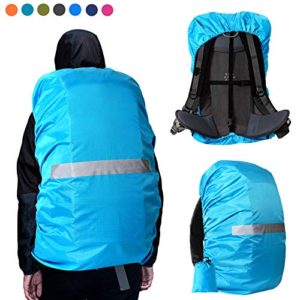
4. Waterproof bags for sealing food
You can also use trash bags for this, or you can get a wet bag like this.
5. Waterproof headlamp
Most good headlamps are waterproof. You will need this, especially for when you have to go to the bathroom at night while it is raining! 😀 Read how to choose a headlamp.
6. Footwear that you can wear in the rain
Be warned that even “waterproof” boots are probably still going to get wet. You’ll also want to bring extra socks. Preferably wool or a synthetic which dries fast.
The reason for extra socks is that wet socks = blisters. You might also use the two-sock system to prevent blisters.
Optional Rain Gear/Supplies
Waterproof pants:
If you are camping in spring or rainy season, I would absolutely recommend getting waterproof pants.
Having waterproof pants means you can go outside in the rain, sit wherever the hell you want, and not get drenched.
Most waterproof pants look like parachute pants from the 80s. My daughter complains about looking dorky. I try to tell her that “being prepared is fashionable” and that there isn’t anyone around to see here anyway. Her response? “What if the bears see me?”
Here are my picks for waterproof pants for women and for kids. Not all of them are dorky looking. 😀
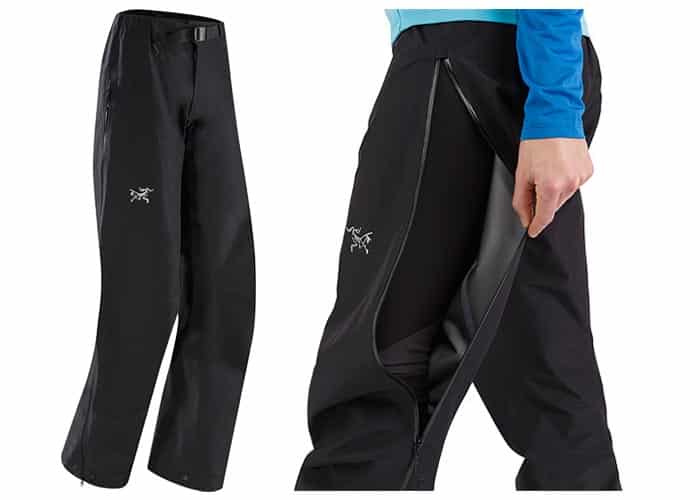
Tarp
Bring a giant tarp with you. Then you can set it up to make a rain shelter to hang out under while it rains. Tarps are also great for creating a shady spot on hot days.
Below are some pictures of tarp setups for rain while camping.
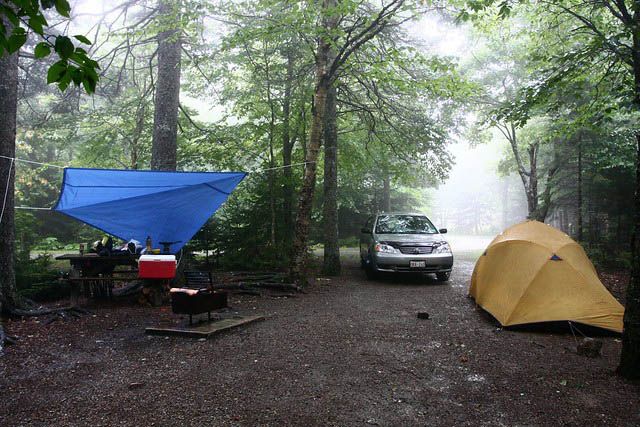
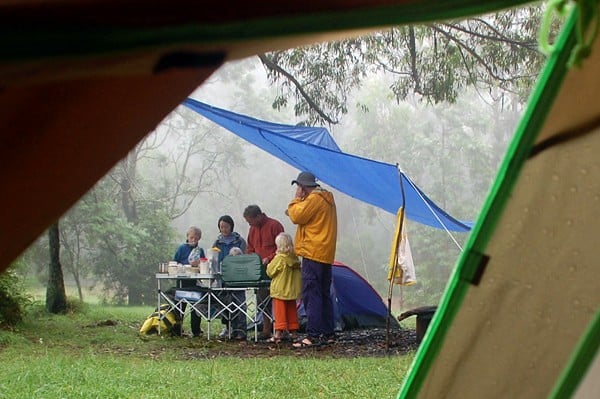
Rope
You should always bring rope while camping. One reason is to you can make a clothesline to hang any items that need to be dried. Ideally, you run the clothesline under the tarp shelter you set up.
Fire starters
Starting a campfire in the rain is a pain in the ass (here’s how to do it). Make life easier on yourself by bringing a few fire starters. My favorite is a cotton ball dipped in vaseline. It will burn for a long time!
Foam Cushion/Seat
After it rains, everything is wet. Having a foam sleeping cushion is great. You can put it anywhere and sit on it – like in front of the fire — so your butt doesn’t get muddy and wet. This one (shown below) folds up so it is easy to pack.
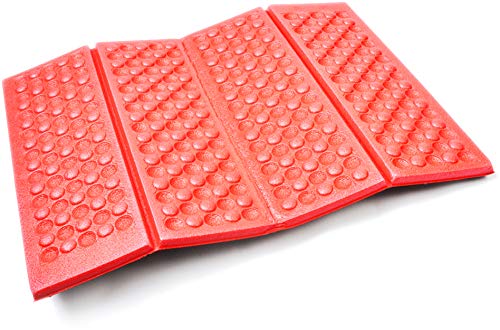
*Not sure what to eat while camping? Check out my ebook. It has over 50 dehydrator recipes. Just add water and you’ve got yourself a meal (even in the rain 😀 ).
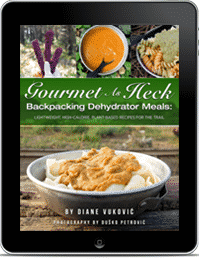
Camping in the Rain with Kids
Bear in mind that little kids have no clue how to be careful/stay dry when it rains. They will stomp right through giant puddles. They will sit in mud. They will slip and fall at the worst possible spots.
Even if you want to keep your kids inside the tent while camping (see ideas for games you can play in the tent later in the post), you’ve still got to consider that it will be muddy after the rain. So, regardless of whether the kids are going out in the rain, they need complete rain gear.
This rain gear includes a jacket AND rain boots AND rain pants.
The boots and jacket might seem obvious. However, I’m a huge fan of rain pants for kids. I even make my 1 year old wear them on trips to the local park. She can then crawl or sit wherever she wants, and I don’t have to worry about grass stains or muddy laundry.
Read: Best rain suits for babies and toddlers
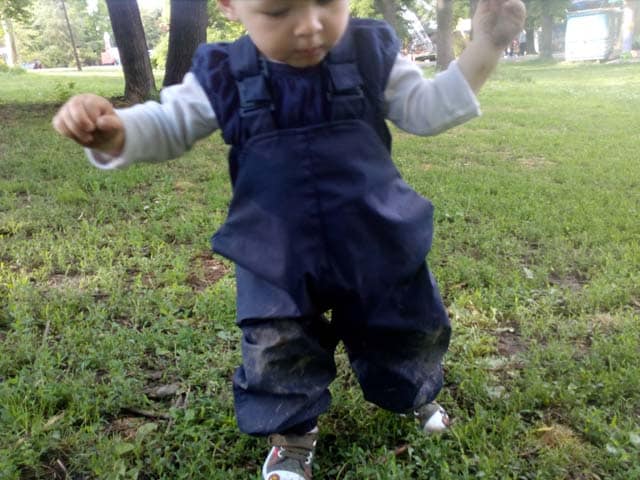
This is my baby at 12 months. I friggin’ love rain pants. They spare me a lot of muddy, stained laundry!
Choosing a Rain-Safe Campsite
When setting up your campsite, keep in mind that it may rain. Look around you. Where will rain come down from the mountains above you? Will the river next to you likely surge?
- Watch out for widow-maker trees. Lots of people die each year when dead tree branches fall on their tents.
- Choose a campsite on elevated land
- Make sure there aren’t any overhangs which water could run off of and onto your tent. You could end up at the bottom of a mudslide!
- Camp on well-drained land. Otherwise you are going to have to step through a mud pit to get in/out of your tent!
- Note the high-water mark in canyons or at dry stream beds. If it rains, flash floods could come to here and wipe you away!
Setting Up Your Tent for Rain
Your tent absolutely must be waterproof! Yes, this sounds obvious but you’d be surprised how many people go camping with a cheap $20 tent which provides no protection from the elements.
When it rains, those “summer tens” will flood the tent and turn it into a giant puddle. Everything inside the tent will get drenched. I’ve seen this happen to other campers on multiple occasions.
Stake Down All Sides of the Rain Fly
I only use double-wall tents (see the picture above). The inner wall is the tent, and the outer wall is the rain fly. When setting up the outer layer, it is really important that you stake down ALL the sides, including the corners and guylines on the walls.
If you don’t do this, the rain fly will droop from the pressure of the rain and the fly and inner tent wall will touch. This will cause condensation to form and your tent will get wet! Any gear touching the walls of the tent will also get wet from condensation!!!
If Your Tent Isn’t Waterproof…
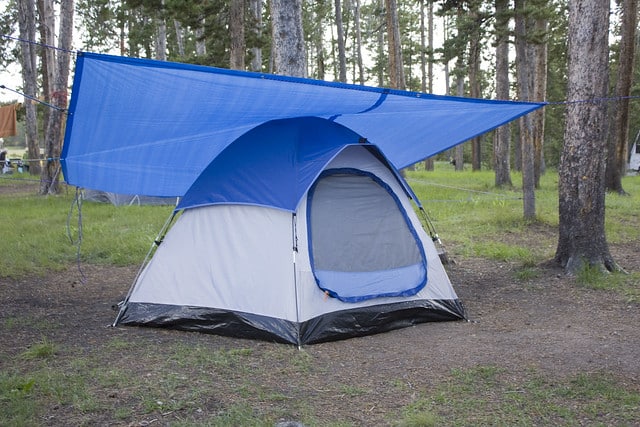
If your tent isn’t rainproof, then you’ll need to set up a rain tarp. You can also set up a rain tarp over your cooking area.
There are a bunch of different ways to do set up a rain tarp. The easiest rain tarp configuration is to make a ridgeline over your tent, drape the tarp over it, and then secure all four corners in place. See how it was done in the second image below.
Tip: Don’t forget about the ground underneath your tent!
Make sure the rain tarp extends well beyond the edges of your tent. Otherwise, rain will fall near the edges of the tent and saturate the ground. This ground water will then leach into your tent, making it all wet on the bottom.
If the bottom of your tent isn’t waterproof at all (or is very thin), then you’ll want to put a tarp under the tent too. Make sure the edges of the tarp are protected by the rain cover. Otherwise, the bottom tarp will just funnel water into your tent.
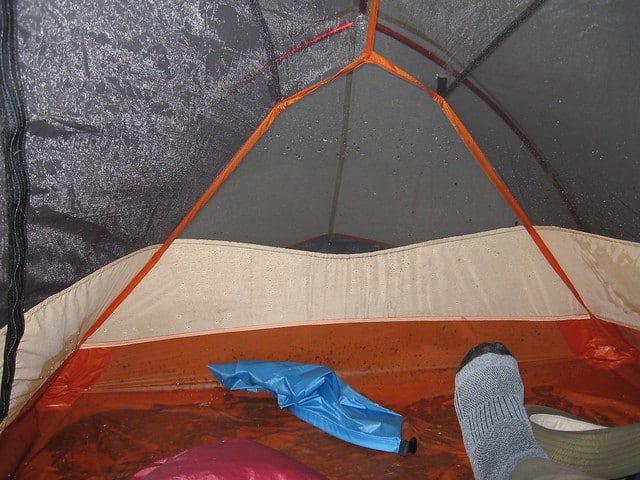
Look how wet the bottom of the tent is!
Example of Bad Tent Setup
Want an example of what NOT to do when camping in the rain? The person in the picture below didn’t have a waterproof tent. Had they set up the rain tarp correctly, things would have been fine.
Their mistakes include:
- Didn’t stake out the corners and sides of the tarp. The tarp touched the sides of the tent, causing them to get wet through condensation.
- Didn’t factor in the bottom of the tent. Since the tarp wasn’t staked out far from the tent, water just dripped to edges of the tent. Within minutes, the bottom of the tent was soaked.
- Left gear outside of the tent. I bet those sneakers are going to take days to dry!
Note: It’s really not that hard to set up a tent for rain. So don’t freak out or worry! I just wanted to show you all the things that can go wrong so you don’t end up in the same predicament.
Cooking during the Rain when Camping
Campfire cooking might be difficult to do in the rain, but you can still use your camping stove in the rain (read about camping stoves here). Just put on your waterproof gear and cook on the camp stove as you normally would. But…
NEVER COOK INSIDE YOUR TENT!
Aside from the obvious fire hazard, there is also a risk of carbon monoxide poisoning if you use gas or charcoal for fuel.
I admit to being lazy at times and sitting with my butt inside the tent and my cook stove right outside of the tent. This is fine because the stove is still outside. Otherwise, we just munch on our trail mix and wait until the rain is over to make meals.
Tip: Bring Meals which Don’t Have to Be Cooked
I now dehydrate all of my own backpacking meals. This means I can bring some really badass gourmet food on our camping trips, but it still only takes a few minutes to prepare.
Most dehydrated meals don’t even need to be cooked. You can just add water to them and wait (though it will rehydrate a lot faster if you use hot or boiling water).
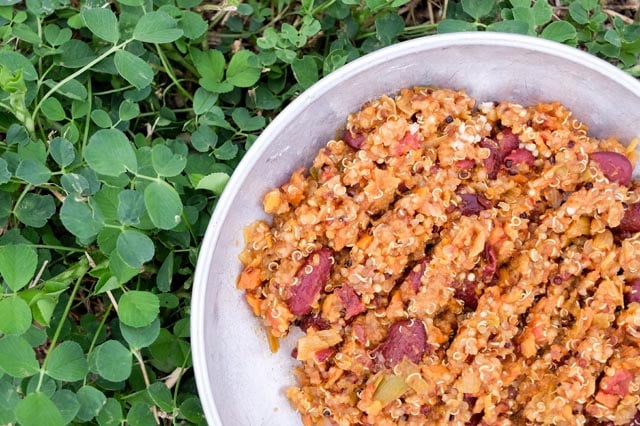
Here’s an example of what I’ll eat while camping. It is quinoa chili. Just add hot water and it rehydrates in 5 minutes.
Want to learn more? Check out my eBook. It talks all about meal planning for backpacking trips plus has over 50 recipes.
Making a Fire After the Rain
Making a fire when it is dry is fairly easy. But, what about campfires after the rain when everything is wet? It takes some knowledge, but is still pretty easy. I’ve got to admit that I feel proud when I get a roaring campfire going when camping in the rain.
Here are the basic steps. Read the detailed instructions on how to make a fire in the rain here.
- Scrape away the wet ground so you have a dry base to make your fire on. Or you can lay down dense branches and make your fire on top of them.
- Use the wood from the bottle of your pile. If you stacked it nicely, it should still be semi-dry.
- Choose the right fire lay for rain. These include an upside down fire or an A-frame fire.
- Use lots of tiny, dry tinder.
- If you can’t find any dry tinder, use your knife to shave the wet bark off of sticks. Keep shaving the stick to create lots of little dry pieces of wood.
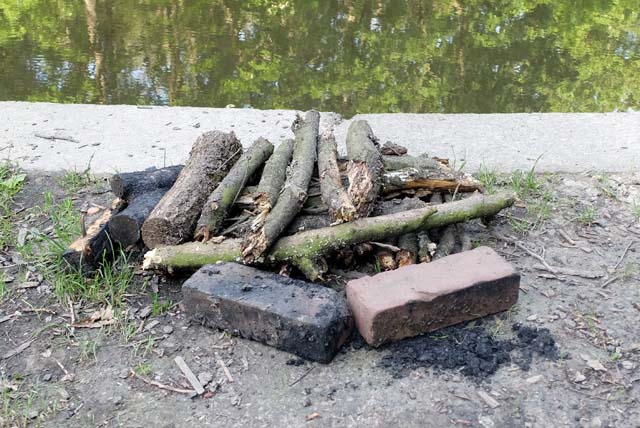
Here’s the start of an “upside down fire.” By making the fire on top of these logs, the fire dried them out.
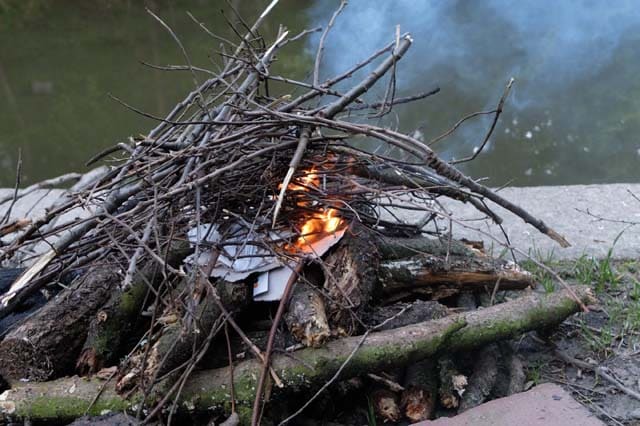
Here’s the upside down fire being lit. I used tons of tinder because everything was so wet.
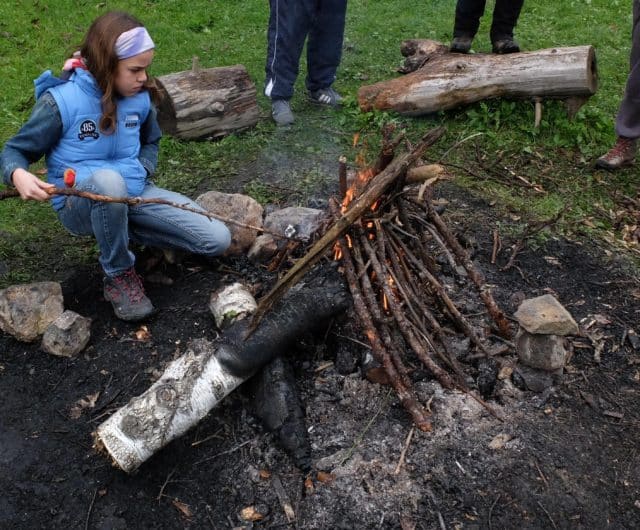
In the photo above, I used an A-frame fire lay. The A-frame construction meant that the sticks on top protected the fire from the rain (it was drizzling).
Other Tips for Camping in the Rain
Keeping Gear Dry
The moment you suspect that it is going to rain, you need to bring your gear to a safe, dry spot (you should be keeping your campsite tidy anyway). Bring in EVERYTHING, even the stuff that is waterproof. If you can’t bring the gear inside your tent, then you better have a tarp to cover it or make a tarp rain shelter.
I made the mistake of not bringing in the camp cookset once because I figured the aluminum plates were waterproof. After the rain stopped, I had to clean lots of dirt and pine needles off the cookset before using it. I learned my lesson and now keep all gear dry.
Games You Can Play in the Tent
Since it usually doesn’t rain for very long while camping in the mountains, my daughter and I usually just retreat to the tent when it starts raining. We always find ways to have fun while in the tent.
One time, we just watched the silhouettes of giant slugs crawling over the outside of the tent. It was actually really fun.
Another time, I found a piece of wire someone had left at the campground and we shaped it into a bunny.
Other times, we get out her notebook and markers (one of the only toys I let her bring camping) and draw, practice writing/reading, or tear up pieces of paper to play Memory.
Here are some other ideas for games you can play inside the tent:
- Bring a deck of cards and play any number of games
- Shadow puppets using your flashlights
- Charades
- Tell stories
You Can Still Go Outdoors When It is Raining
Just because it is raining, it doesn’t mean that you can’t play outside. All you need is a rain jacket or poncho, and preferably some waterproof boots (you can walk outside in your camp sandals, but bear in mind that it gets slippery in the rain so boots are better) and rain pants.
We had some nice showers on our last camping trip in the mountains. Isabel didn’t feel like staying in the tent though, so I let go out and pick wild blueberries and strawberries. While she was doing that, I tested myself to see if I could get a fire going in the rain. Yes, I succeeded!
Contingency Plan for Rain
Even if the weather forecast calls for sunshine every single day, you should still plan for your camping trip as though it will rain. I sometimes make a contingency plan in case it pours for days without stop.
For example, when backpacking in Rugova Klisura in Kosovo, I knew that there were cabins for rent by the trail head. The trail to the campsite is very steep. I wasn’t about to hike up it with a 4-year old in the rain! The rain contingency plan was that we’d wait until dry weather to go up. Luckily, I’ve never had to use my contingency plan.
Rain Is Beautiful!
Okay, maybe the rain itself isn’t always beautiful. But I love the moments after the rain stops. If you are high up in the mountains, you can literally see the clouds clearing away. It looks like steam floating across the ground. Sometimes it feels like you can touch it. And, if you are in a plain, you might even get a rainbow afterwards 🙂 So enjoy the rain! We wouldn’t have such beauty without it.
Image credits:
Sean Munson Tents and Puddle CC BY NC ND 2.0, found on Flickr
Joseph Tarp camp, Southeast Alaska CC BY SA 2.0
Thejaswi I Our tent CC BY SA 2.0
Grant Eaton Denali Double Rainbow Panorama CC BY NC ND 2.0
Daniel Ladenhauf Dry Campground CC BY NC 2.0
“Rainy Campsite” (CC BY-SA 2.0) by Martin Cathrae
“nice view from the tent” (CC BY-NC-ND 2.0) by behang
“Campsite” (CC BY 2.0) by Colin McMillen
“extra rain protection” (CC BY-NC-ND 2.0) by chanzi
“Inside of tent on Loon Lake” (CC BY-NC-ND 2.0) by TimDan2


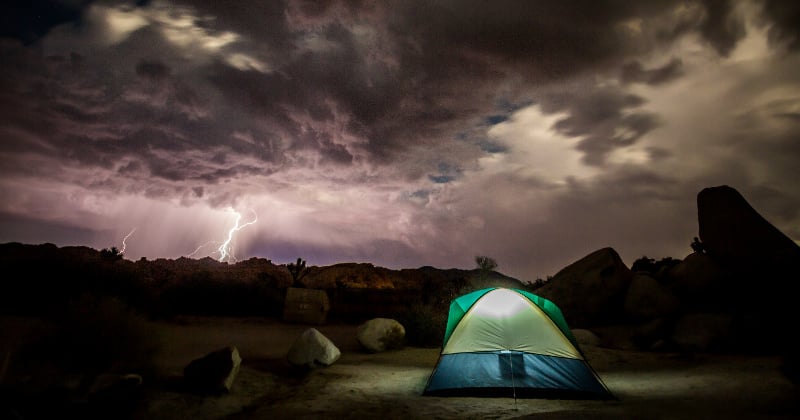
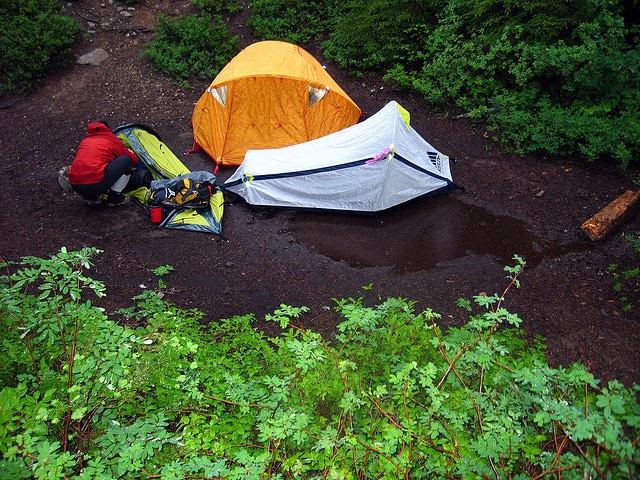
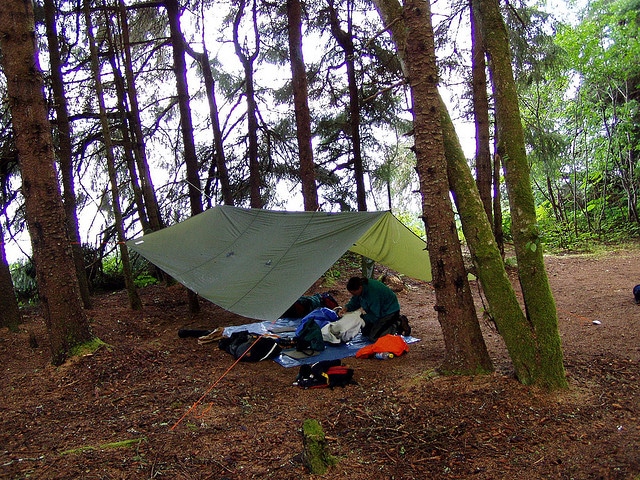
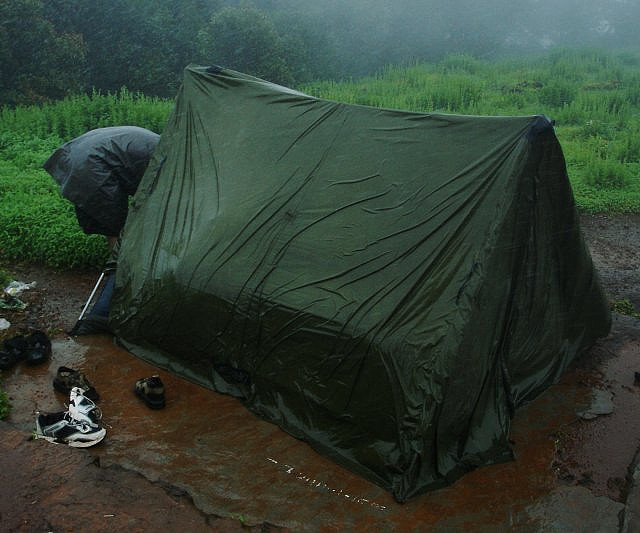
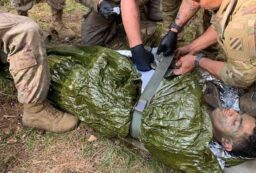
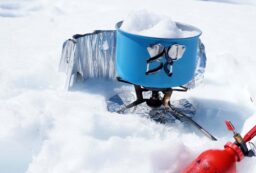








1 Comment
ROD NIELSEN
November 28, 2020 at 5:06 amSolved: “If your tent isn’t waterproof”
This illustration is of the absolutely perfect campsite. PERIOD!
Now, during the night, the following day and, indeed, for weeks afterward there will be adjustments made to the materials, and arrangement, to meet the unforeseen needs of the site environs. THAT IS ALL! There is no other way to find a perfect campsite, tent, tarp and gear to suit any one person, occasion, budget and storage space = experience!